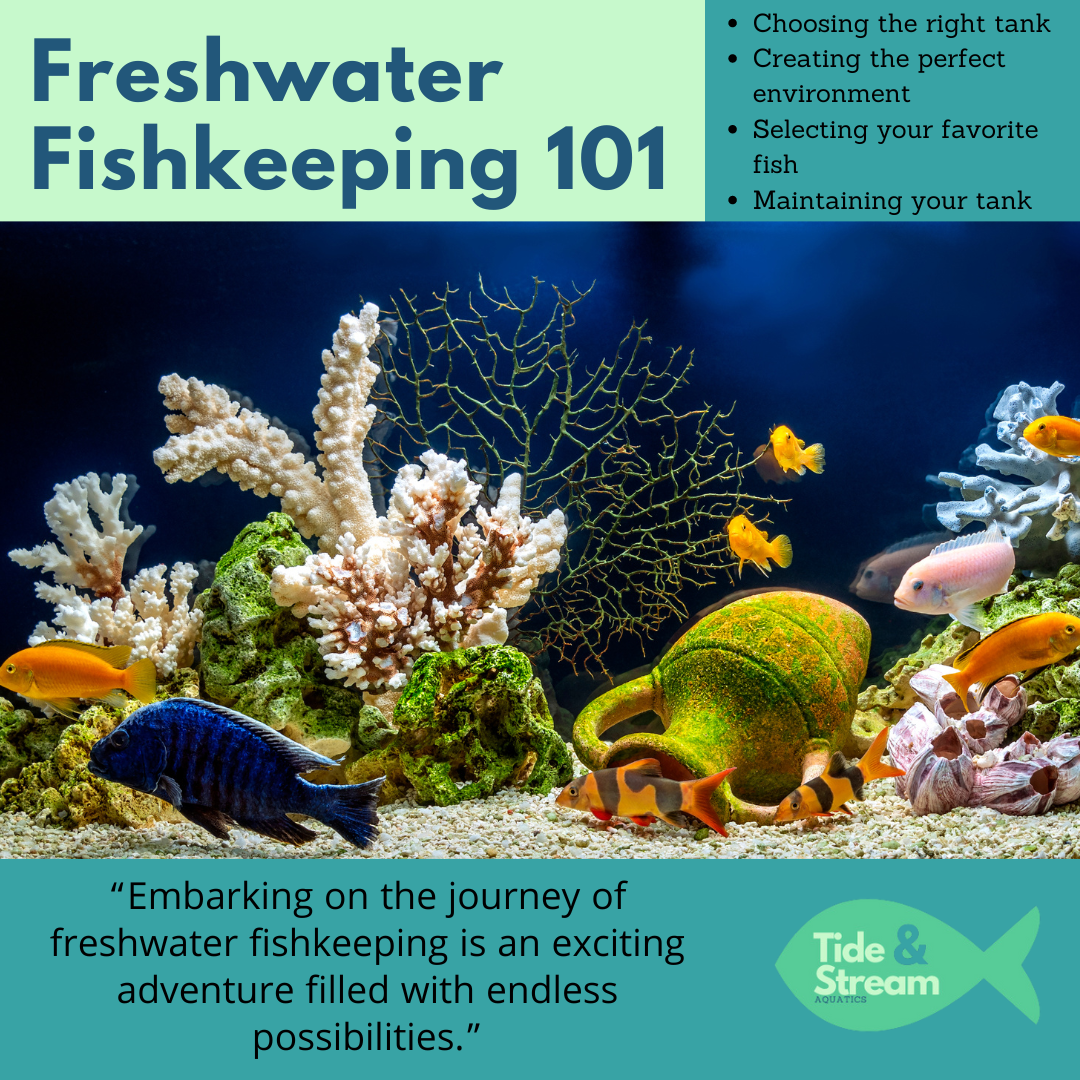
Freshwater Fishkeeping 101
Share
Why have a freshwater aquarium?
So, you're thinking about diving into the world of fishkeeping? Congratulations! You're about to embark on a rewarding hobby that can bring a touch of nature indoors. While saltwater aquariums offer their own unique charm, freshwater tanks often provide a more accessible and manageable starting point.
Freshwater aquariums boast a remarkable diversity of life. From the vibrant colors of Neon Tetras to the graceful movements of Angelfish, there’s a freshwater species to captivate every enthusiast. Whether you prefer a peaceful community tank or a more challenging cichlid setup, the possibilities are endless.
Another advantage of freshwater aquariums is their lower maintenance requirements compared to saltwater tanks. While both ecosystems demand attention, freshwater setups generally involve less complex water chemistry and equipment. This makes them ideal for beginners or those with busy lifestyles.
Moreover, freshwater fish tend to be more affordable than their saltwater counterparts. This allows you to experiment with different species and tank setups without breaking the bank. Plus, there's a vast array of freshwater plants available, enabling you to create stunning underwater landscapes that are both visually appealing and beneficial for your fish.
Lastly, freshwater aquariums offer a tranquil and relaxing atmosphere. The gentle movement of the water and the mesmerizing behavior of fish can have a calming effect on your mind and body. It's a wonderful way to unwind after a long day or escape the hustle and bustle of everyday life.
Whether you're seeking a hobby, a beautiful centerpiece for your home, or a way to connect with nature, a freshwater aquarium is an excellent choice. With careful planning and a little knowledge, you can create a thriving underwater world that brings joy for years to come.
Choosing the Right Aquarium
Selecting the perfect aquarium is the foundation for a thriving underwater ecosystem. Consider these key factors when making your choice:
Size Matters: The size of your aquarium will determine the number and type of fish you can keep. A general rule of thumb is that bigger is better. Larger tanks are more stable, making it easier to maintain water quality. For beginners, a 20-gallon tank is a good starting point, but if you have the space, a 29-gallon or larger tank offers more flexibility.
Shape and Style: Aquariums come in various shapes, including rectangular, bow-front, and corner tanks. The shape can influence the overall aesthetic of your tank. Rectangular tanks are the most common and offer the most flexibility in terms of placement and equipment. Bow-front tanks provide a wider viewing area, while corner tanks maximize space utilization.
Consider Your Space: Before purchasing an aquarium, carefully measure the space where you plan to place it. Ensure you have enough room for the tank itself, as well as equipment like the filter, heater, and lighting. Also, consider the weight of the filled aquarium, especially if you're placing it on a second-floor or elevated surface.
Think About Your Fish: The type of fish you want to keep will also influence your aquarium choice. Some fish require specific water parameters or have unique behavioral needs. For example, cichlids often prefer tanks with plenty of hiding places, while peaceful community fish thrive in open spaces.
Budget: Aquariums come in a wide range of prices. Consider your budget when choosing a tank and equipment. Remember, the initial cost is just the beginning; ongoing maintenance expenses, such as fish food, water conditioners, and replacement filters, should also be factored in.
By carefully considering these factors, you can select an aquarium that meets your needs and sets the stage for a successful fishkeeping experience.

Creating the Perfect Environment
Once you've chosen your aquarium, it's time to transform it into a thriving underwater ecosystem. Creating the perfect environment starts with the substrate and decor.
A suitable substrate is crucial for both the aesthetics and health of your aquarium. Gravel or sand can be used, but specialized aquarium substrates often provide additional benefits. These substrates can help maintain water quality, support plant growth, and create a natural look.
Aquascaping is the art of arranging your aquarium's decor to create a visually appealing underwater landscape. Driftwood, rocks, and plants are common elements used in aquascaping. Driftwood adds a natural touch and provides hiding spots for fish. Rocks can be stacked to create interesting formations or used as anchors for plants.
When choosing plants, consider the lighting conditions in your aquarium. Some plants require high light, while others thrive in low-light environments. A variety of plant types can add depth and dimension to your aquascape. Remember to research the care requirements of each plant species to ensure their survival.
Creating a balanced ecosystem involves more than just aesthetics. The arrangement of your decor should also consider the needs of your fish. Provide ample swimming space, hiding spots, and areas for exploration. Avoid overcrowding your aquarium with decor.
By carefully selecting your substrate, decor, and plants, you can create a visually stunning and biologically balanced aquarium that will be enjoyed by both you and your fish.
Selecting your First Fish
Selecting the perfect inhabitants for your aquarium is an exciting step in the fishkeeping journey. With thousands of freshwater species available, it can be overwhelming. Here are some key factors to consider when choosing your fish:
Tank Size and Compatibility: The size of your aquarium will determine the number and types of fish you can accommodate. Research the adult size of your chosen species to avoid overcrowding. Compatibility is crucial for a harmonious tank. Some fish are peaceful community dwellers, while others are territorial or aggressive. Mixing incompatible species can lead to stress, bullying, or even fatalities.
Water Parameters: Different fish have specific water requirements regarding temperature, pH, and hardness. Ensure your chosen species can thrive in your aquarium's water conditions. If necessary, you can adjust these parameters using water conditioners or additives.
Behavior and Activity Levels: Consider the temperament and activity levels of your fish. Some fish are shy and prefer hiding places, while others are energetic swimmers. A well-balanced community includes a mix of both.
Diet: Research the dietary needs of your fish. Some species are omnivores, while others are primarily carnivores or herbivores. A varied diet ensures optimal health and vibrant colors.
Schooling Fish: Many fish, like tetras and barbs, are schooling fish and prefer to live in groups. Providing a school of at least six individuals will enhance their natural behavior and reduce stress.
Beginner-Friendly Options: If you're new to fishkeeping, consider starting with hardy and adaptable species like guppies, Neon Tetras, or Mollies. These fish are relatively tolerant of water parameter fluctuations and are less prone to diseases.
Remember, it's essential to research each species before bringing them home. Understanding their specific needs will help create a thriving and enjoyable aquarium environment.
Aquarium Maintenance
Maintaining a healthy aquarium requires consistent care. While it might seem daunting, regular maintenance is essential for the well-being of your fish.
Water Changes: One of the most crucial aspects of aquarium maintenance is performing regular water changes. This helps to remove accumulated waste products like ammonia, nitrite, and nitrate. Aim for a 25% water change every one to two weeks. Use dechlorinated water to replace the removed water.
Filter Maintenance: Your aquarium filter is a vital component in maintaining water quality. Clean the filter media according to the manufacturer's instructions. Be careful not to rinse the biological filter media with tap water as it can kill beneficial bacteria.
Gravel Cleaning: Over time, debris and waste accumulate in the gravel. Use a gravel vacuum to remove this buildup during water changes. Be gentle to avoid disturbing the beneficial bacteria that live in the substrate.
Tank Cleaning: Regularly clean the inside glass of your aquarium to prevent algae growth. Use an aquarium-safe algae scraper to remove stubborn algae.
Water Testing: Invest in a water testing kit to monitor key parameters like ammonia, nitrite, nitrate, pH, and temperature. Regular testing helps identify potential problems early on.
Feeding: Avoid overfeeding your fish. Uneaten food can decompose and contribute to water quality issues. Feed your fish small amounts multiple times a day instead of large meals.
Observe Your Fish: Pay attention to your fish's behavior. Any signs of illness, unusual swimming patterns, or loss of appetite should be investigated promptly.
By following these basic maintenance steps, you can create a thriving underwater ecosystem for your fish. Remember, consistency is key. A little effort goes a long way in ensuring the health and happiness of your aquatic companions.

Final Thoughts
Embarking on the journey of freshwater fishkeeping is an exciting adventure filled with endless possibilities. By carefully selecting your aquarium, creating a suitable environment, and choosing compatible fish, you can build a thriving underwater world.
Remember, patience and dedication are key to successful fishkeeping. Regular maintenance, water quality monitoring, and attentive observation of your fish will help prevent common problems and ensure the longevity of your aquarium. With proper care, your freshwater aquarium can become a cherished hobby that brings joy and relaxation for years to come.

